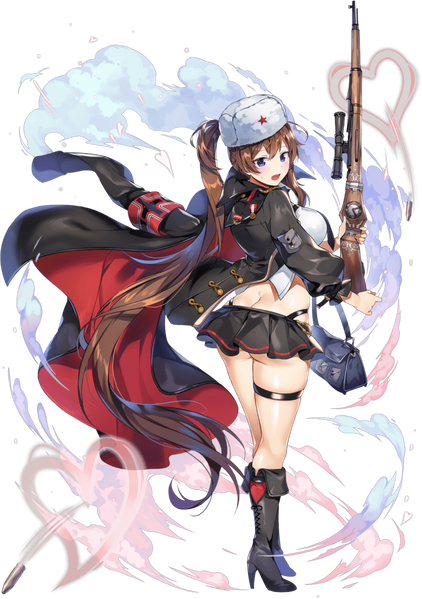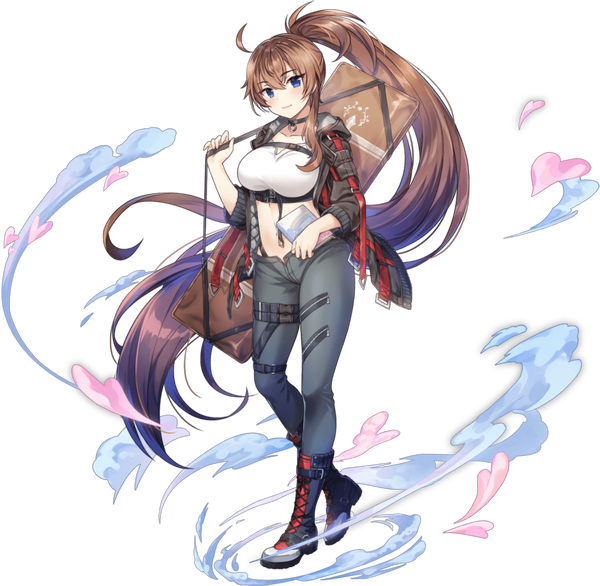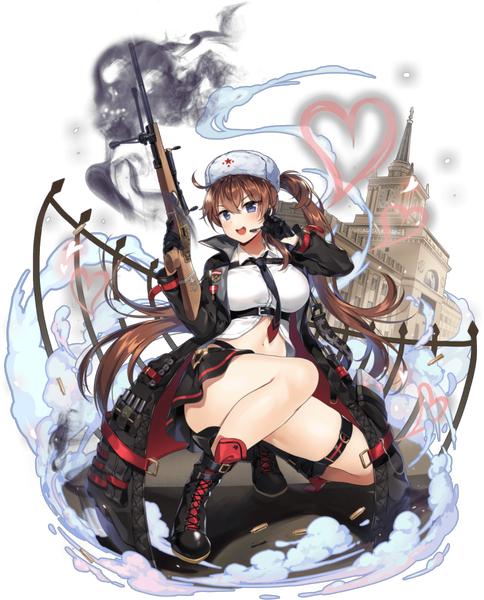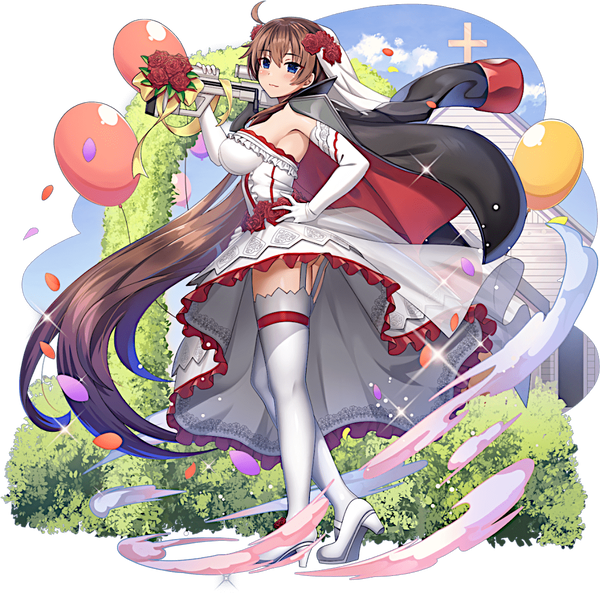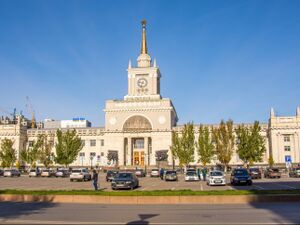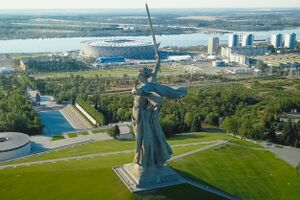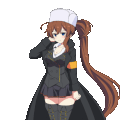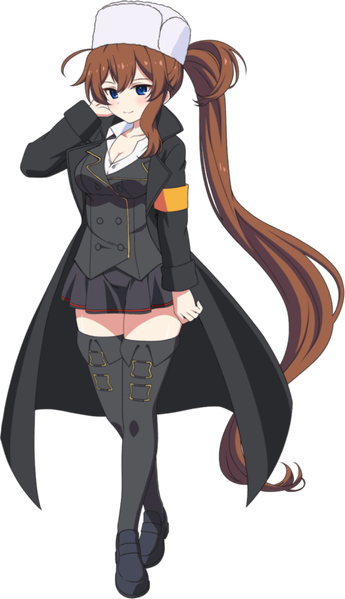
Volgo
Jump to navigation
Jump to search
| Volgo | |||||
|---|---|---|---|---|---|
| Japanese Name | ヴォルゴ | ||||
| Weapon | |||||
| Race | Human | ||||
| Nationality | |||||
| Birthday | March 27 | ||||
| Constellation | Aries | ||||
| Talents | Sniping, Cooking, Sewing | ||||
| Likes | Sappy romance novels | ||||
| Dislikes | Overly chatty people, Places without any cover | ||||
| Strengths | Very patient | ||||
| Weaknesses | Lacking a sense of humor, Stern expression | ||||
| Hobbies | Theater, Reading, Making sweets | ||||
Name's Volgo. I belong to the sniper division of the Eisengrad Northern Army. I don't know what you've heard of me, but I'm by no means an elite soldier. I'm just good at handling a gun. So don't take it away from me. I'll quit if I don't have my gun to shoot. No changing my mind about that.
Layers
| Icon | Title | Release Date | Where to Obtain |
|---|---|---|---|
| [Heroic Sniper] Volgo | 2021 August 30 (EN) | Premium Gacha | |
| [Single-Minded Maiden] Volgo | 2021 August 30 (EN) | Premium Gacha | |
| [Sniper on Holiday] Volgo | 2022 February 24 | [Undercover Mission and the Steel Mechanic] Limited Gacha | |
| [Death God of Loren Wall] Volgo | 2022 April 15 (EN) | [Forest Rangers' Eclair] Pick Up Gacha, Premium Gacha | |
| [Wishing for a Happy Future] Volgo | 2023 July 31 | Premium Gacha |
Owned Skills
Trivia
- Volgo's birthday is the Day of the internal troops of the MIA of Russia (MIA Day). It is the professional holiday of all employees and officers of the internal troops of the Ministry of internal Affairs of the Russian Federation, instituted on 1996.
- The design of Volgo and her former occupation as a clerk, is a homage to Vassili Grigoryevich Zaitsev, who was a Soviet sniper during World War II. Zaitsev became a celebrated figure during the war and later a Hero of the Soviet Union, and he remains lauded for his skills as a sniper. His life and military career have been the subject of several books and films: his exploits, as detailed in William Craig's 1973 book Enemy at the Gates: The Battle for Stalingrad, served as the story for the 2001 film Enemy at the Gates, with Jude Law portraying Zaitsev.
- The medal pinned at the back of the [Single-Minded Maiden] outfit bears resemblance to Order of the Red Banner, which is an award that Vassili also received.
- Volgo's hat in [Single-Minded Maiden] and [Death God of Loren Wall] feature the red star. Five-pointed and filled, the red star is a symbol that has often historically been associated with communist ideology, particularly in combination with the hammer and sickle, but is also used as a purely socialist symbol in the 21st century. It has been widely used in flags, state emblems, monuments, ornaments, and logos.
- Volgo's title, [Death God of Loren Wall] is a reference to the Battle of Stalingrad, the deadliest battle to take place during the Second World War and is one of the bloodiest battles in the history of warfare, with an estimated 2 million total casualties. The Siege of Loren Wall in Mist Train Girls is similarly one of the deadliest defensive battles against the Mist Monsters by the SSS against the Wandering Lives.
- The gun Volgo uses is a Mosin Nagant, also used by Vasily Zaitsev. Developed from 1882 to 1891, it was used by the armed forces of the Russian Empire, the Soviet Union and various other states. It is one of the most mass-produced military bolt-action rifles in history, with over 37 million units produced since 1891. In spite of its age, it has been used in various conflicts around the world up to the present day.
- The building in the background of [Death God of Loren Wall] features the Volgograd-Glavny station. Volgograd was formerly Stalingrad. The original station was completely destroyed during World War 2.
Counterpart
Volgograd-Glavny is a major junction railway station of Volgograd in Russia. It is located in the Central District of the city at Railway Station Square, 1. The station is one of the largest in Russia and serves long-distance trains and suburban trains. The station is the hub for services to five main destinations: Krasnodar, Rostov-on-Don, Moscow, Saratov and Astrakhan.
The first railway to serve Tsaritsyn (now Volgograd) was the Volga-Don railway in 1862. The first railway station was constructed of wood. In 1871 the station was replaced with a brick structure.
During the Second World War, the building was almost completely destroyed in the Battle of Stalingrad. Immediately after the surrender of the German troops, the restoration of the building and the damaged railway track began. Already on March 14, 1943, the first train from Moscow arrived in the city. On March 31, the Saratov direction was launched. By July 1943, the station was operating at full pre-war capacity. During the restoration of the station, a temporary wooden building was built nearby. After the end of the war, it was decided not to restore the old station building, but to build a new one. In the period from July 1951 to May 1954 the new station building was erected on the site of the old building. The station commissioned June 2, 1954. In 1997 the building of the railway station was designated an architectural monument.
The building is an example of the Stalinist architecture style which was popular in Russia from the 1930s until Stalin's death in the 1950s. The station is a three-story building with a ground floor tower crowned with a spire. The building is made of a combination of brick and concrete, the facade consists of ornamented granite. The interior walls are mainly marble. The ceiling is decorated with stucco and several paintings of the battles that took place in the city. Wikipedia
Volgograd (Волгогра́д), formerly Tsaritsyn (Цари́цын) (1589–1925), and Stalingrad (Сталингра́д) (1925–1961), is the largest city and the administrative centre of Volgograd Oblast, Russia. The city lies on the western bank of the Volga, covering an area of 859.4 square kilometres (331.8 square miles), with a population of over 1 million residents.
On April 10, 1925, the city was renamed Stalingrad in honor of Joseph Stalin. During World War II, the Axis forces attacked the city, leading to the Battle of Stalingrad, one of the largest and bloodiest battles in the history of warfare. On 10 November 1961, Nikita Khrushchev's administration changed the name of the city to Volgograd. After the dissolution of the Soviet Union, the city became the administrative centre of Volgograd Oblast.
Known locally as the "Hero City", Volgograd today is the site of The Motherland Calls. The Motherland Calls (Родина-мать зовёт!) is the compositional centre of the monument-ensemble "Heroes of the Battle of Stalingrad" on Mamayev Kurgan in Volgograd, Russia. The statue is designed in the Soviet style of socialist realism. It was designed by sculptor Yevgeny Vuchetich and structural engineer Nikolai Nikitin, and declared the tallest statue in the world in 1967. At 85 m (279 ft), it is the tallest statue in Europe, the tallest outside of Asia and the tallest statue (excluding pedestals) of a woman in the world. Wikipedia
Map
Gallery
Categories:
- Pages using Tabber parser tag
- Pages using DynamicPageList3 parser tag
- Weapon Gun
- Human
- Eisengrad
- Aries
- Element Pierce
- Element Wind
- Element Fire
- Element Water
- Train Knights
- Russia

